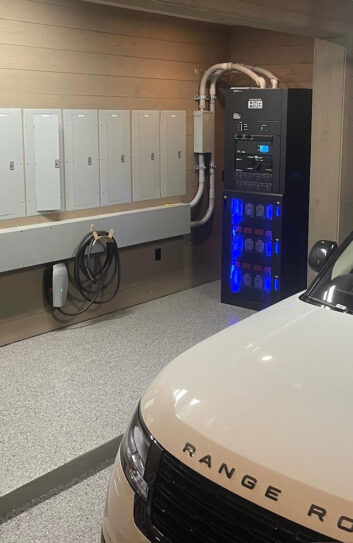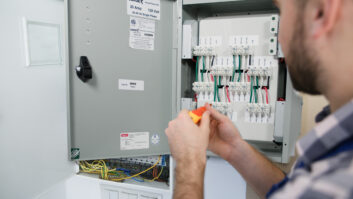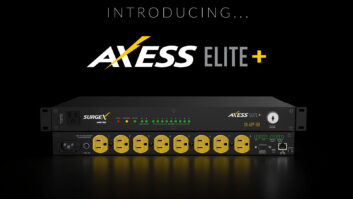There’s no doubt, after witnessing the impact of unstable, unreliable electrical power on the performance and longevity of smart systems, that electrical issues are reaching a state of serious concern. So why aren’t more integrators tackling the issue?
As we discovered during educational courses, panel discussions, and conversations with integrators, misconceptions and uncertainty about the power management category may be to blame for integrators’ reticence. Here, we aim to bust some of the common myths that may be inhibiting adoption of a very necessary, foundational element of today’s high-tech luxury homes:

Myth #1: My customers don’t want to spend money to improve the quality of power in their homes. Remember when we thought customers would never spend a dime for a better network? Wow, were we wrong! As more and more smart devices proliferated the home, bandwidth was squeezed, creating a host of connectivity issues. It wasn’t long before consumers were damning shoddy Wi-Fi and putting down extra cash for a better solution.
There’s a similar shakeup happening with electrical power in the home. With each new microprocessor-embedded product that’s added to a residence, there’s another glitch just waiting to happen. According to the North American Electric Reliability Corp as reported by the Washington Post, the energy demand in North America more than doubled from 221,000 kilowatt hours in 2022 to 564,000 kilowatt hours in 2023. Driven by the rapid innovation of artificial intelligence and the development of new data warehouses, the growth is putting a noticeable crimp in the aging power grid. Whether the issue manifests in fuzzy video, staticky music, system reboots, or frequent outages, consumers are fed up…and ready to pay for a full-scale remedy.
If you or your customers think power is not an issue, consider observations from Wisconsin Power after extensive research of its grid: “Power quality problems can affect many appliances in your home, especially electronic equipment dependent on microprocessors. Computers, stereo systems, satellite receivers, and other appliances may be damaged or may fail prematurely if they are not protected from harmful voltage changes and related disturbances.”
There’s a reason your customers invest handsomely in lighting control, automation, AV, and other tech amenities — it enriches their lifestyle. So, too, does a power management system that keeps the entire home operating optimally. As you do with all the subsystems you sell, with power-related products it’s your job to identify the degree of protection and conditioning your customers desire and build a budget and solution around that.
Myth #2: Surge suppressors mitigate most of the issues, so why do anything more? Certainly, protecting equipment from damaging electrical surges and spikes is important, and surge suppressors do a good job of this, but many other facets of electrical power must be addressed to ensure optimal performance and longevity of every system in the house. For example, an independent surge suppressor may be a good solution if your client’s only concern is protecting the home office equipment. A separate power conditioner has its place, too, often commissioned to regulate the voltage in a high-end home theater. But today, more than ever, consumers need a complete solution that conditions, cleans, and stabilizes incoming electrical power as it protects against damaging grid anomalies and keeps all devices and systems — not just a select few — operational during a power outage. A comprehensive approach to power quality assures customers that no matter what happens on the electrical grid or what Mother Nature dishes out, the downtime associated with power issues is eliminated. Your customers value their free time above all else — it’s why they invested in technology in the first place. Without the addition of a complete power management system, they’ll have less free time as they wait for you to fix and replace equipment, or the power to resume.
Myth #3: Power management doesn’t allow for customization. Just as solutions for lighting control range from a simple dimmer to a whole-house system, so too do products and systems that improve the quality of electrical power in a home. Your job is to determine what your clients are most concerned about protecting from fluctuating voltage, damaging electrical disturbances, and power outages and build a power plan around it. For example, a wine collector might be only concerned with maintaining a safe temperature in the wine cellar during an outage, while another family wants every system in the house to remain operational. Others might want to mitigate issues with their AV equipment and ensure their expensive, customized lighting system works without fail. Some people are willing to deal with the downtime associated with service calls; others won’t stand for it. These differing needs and expectations translate to varying degrees of power management, be it a surge suppressor, power conditioner, battery backup, generator, or a whole-house solution that regulates, conditions, and protects every system from every type of electrical disturbance.
Related: Increasing Interest in Power
Myth #4: I need an electrician on staff to install a power management system. A power management system sits on a home’s electrical lines, so, yes, a licensed electrician is required for hookup. However, this doesn’t mean you need this professional on staff. In fact, you won’t need to commit any additional resources at all to the commissioning of a power management system — as long as you align with a manufacturer who will handle it for you. A manufacturer that offers white-glove service and support will specify the proper equipment for the application, design and configure it appropriately, deliver it to the job site, and work collaboratively with all building professionals, including the electrician, to ensure the system meets all customer expectations. One of the most important first steps when adding power management to your portfolio, therefore, is finding a provider who will handle every detail from start to finish so you can focus on other aspects of the job.
Myth #5: Power management is unprofitable. Au contraire. With the support of an experienced, well-established manufacturer of power quality solutions, power management can be the most profitable part of your business. Why? Because, unlike other emerging categories, it allows you to easily scale dollars per job. Just one sale of a whole-house power management system adds significant revenue. The system is commissioned completely by the manufacturer, so there’s no need to allocate resources. Moreover, once the system is up and running, you’ll realize a huge reduction in costly service calls. One integrator reported an 80 percent decrease in service calls since including large-scale power conditioning in clients’ homes.
It’s time to embrace power as a foundational part of your business. Electricity is the lifeblood of every system you install. When there’s inadequate juice due to disturbances and fluctuations on the power grid, every piece of electronic equipment suffers. Solutions are widely available and represent a huge revenue opportunity. Plus, your customers are all too familiar with the issues, making power management a relatively easy sell.
If you’d like to learn more about the state of electrical power in the U.S., its impact on home technology and systems that deliver clean, reliable electrical current to all the systems you design and install, please visit www.rosewaterenergy.com. We’re happy to help!






